| Construction Rating: | starstarstarstarstar_border |
| Flight Rating: | starstarstarstarstar |
| Overall Rating: | starstarstarstarstar_border |
| Manufacturer: | RocketHead Rockets |

OVERVIEW:
A single-stage rocket 4FNC rocket with fins shaped like axe blades.
Kit Specifications (from the cover art)
- 18 1/4" Tall
- 5 3/4" Fin Span
- 1.8 oz
- Laser cut 1/16" ply fins
- Balsa nose cone
- Kevlar® shock cord mount
- 12" Mylar parachute
- Water slide decals
This kit was my prize for placing second in EMRR Virtual Contest #4. The kit fits into a small plastic bag with a cardboard hang tag. On the back of the hang tag is a certificate for Rockethead Fun Points which can be collected and exchanged for other Rockethead products.
Parts List
- Fins - Laser cut 1/16" plywood
- Nose Cone - Hand turned balsa
- Recovery Components:
- RHR Mylar parachute
- Elastic shock cord
- Kevlar® shock cord anchor
- Screw eye
- Motor Mount assembly
- Body Tube
- Decals - Water slide
The instruction manual is printed on 8 half-sheet pages and is copiously illustrated with color photos.
CONSTRUCTION:
Construction begins by assembling the motor mount in the conventional manner. The instructions call for the motor mount to be glued into the body tube next. I did not like the shock cord attachment method that was called for later in the instructions, so I attached a longer piece of Kevlar® cord as a shock cord anchor before gluing the motor mount into the body.
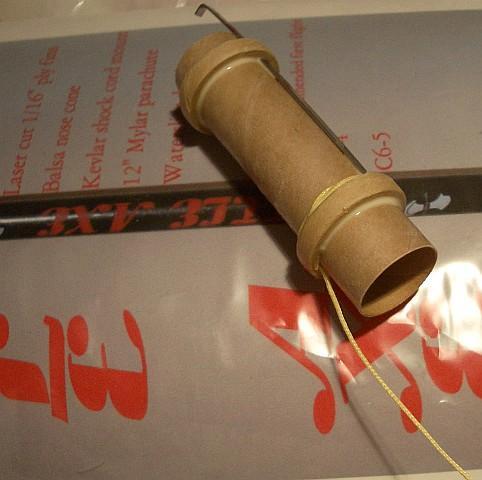
The instructions next call for the fins to be sanded smooth. Since this was supposed to be an axe, I could not resist the urge to sharpen the curved edges of the blades. The plywood used for the fins is surprisingly strong for its thickness and held up well during the sanding and later flights.
I like to have nice crisp color seams where the fins join the body, so I often paint my fins before I attach them. First I masked off a strip along the root edge so the glue would have a place to adhere. Next I sprayed two coats of white primer and sanded between coats. Finally I sprayed two light coats of Rustoleum Metallic Copper. This gives a very nice color to the fins.
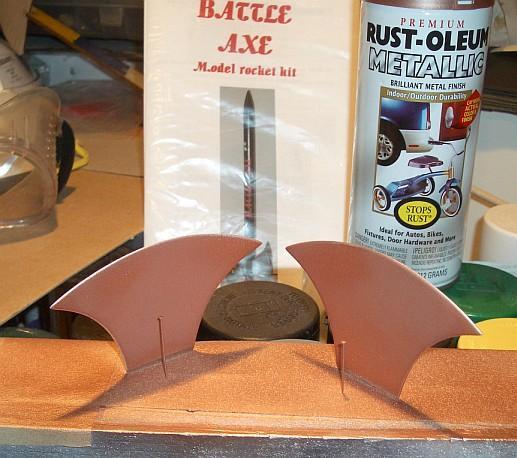
At the same time I sprayed the fins I also painted the nose cone. Rockethead turns their own nose cones, and this one was a work of art. The factory finish on it is so nice I did not even need to sand it -- I was able to go straight to primer. Two coats of primer, light sanding, and a coat of Metallic Copper made the nose cone look really nice.
My original plan was to paint the body brown so that it would look like a wooden axe handle. After spraying the tube with Rustoleum Rust Red Primer, I saw that there would not be much contrast between the reddish-brown body and the copper fins, and the decals would not show up well against the brown. So I sanded the tube down until it was almost bare. The spirals on the tube were so small that this one coat of primer was all that was required to fill them.
Returning to the directions, the next step is marking the body tube and attaching the fins. The instructions call for tacking the fins in place with CA and then applying wood glue fillets.
I used 5-minute epoxy for the fillets. First I applied low-tack masking tape on the fins to the same portion I had left bare during the painting process. Then I applied epoxy fillets using a popsicle stick to get a good smooth curve. I removed the masking tape once the epoxy had gelled, leaving a nice clean edge. The epoxy was probably overkill for a model of this size.
Next I attached the launch lug using CA with wood glue fillets. I wish I had done this before attaching the fins, because it would have been easier to fillet the lower launch lug that is between the fins.
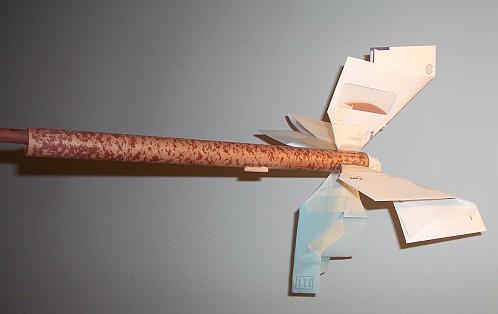
After letting the fillets dry overnight I was ready to paint the body. To protect the fins, I inserted each one into an old envelope and used low-tack masking tape to seal along the sharp edge of the epoxy fillet.
A single coat of Gloss Black Rustoleum Painter Choice paint did a fine job on the body.
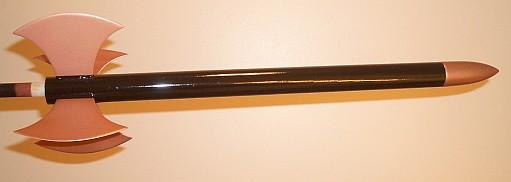

After the paint dried, it was time to add the decals. The water-slide decals were high-quality, and were fairly easy to apply.
The stock decal scheme called for tiny axes to be place on each fin, but I didn't want to cover up the nice copper finish so I limited myself to a single axe on the body. I also had some red stripes left over from a Rockethead RHR2003 that I had just finished building, so I added them to the body, as well as a tiny Rockethead logo. The red decals show up nicely against the black, unlike some decals that are too transparent and disappear on a dark background.
The final finishing step was two coats of Rustoleum Gloss Clear. Even though the base coat had dried for 3 days beforehand, some of the black paint near the bottom crinkled when I applied the first layer of clearcoat. Dang! Disappointed, I set it aside for about 2 weeks before I lightly sanded the crinkles and applied a second clear coat.
The final construction step is screwing a screw eye into the base of the nose cone and attaching the shock cord to the nose cone and shock cord anchor. A hardwood plug in the nose cone base makes for a very durable attachment point for the screw eye.
Construction Rating: 4 out of 5
FLIGHT/RECOVERY:
The instructions suggest A8-3 (first flight), B6-4, and C6-5. RockSim confirms that these would be good choices. The B4-4 should also work well.
| Engine | Max Alt (feet) |
Optimum Delay (sec) |
| A8-3* | 300 |
3.4 |
| B4-4 | 630 | 4.5 |
| B6-4* | 640 |
4.5 |
| C6-5* | 1200 | 5.5 |
| *= Recommended by Manufacturer | ||
Test Flights:
The first two test flights took place on a cold clear late afternoon in January, with a light breeze and temperature in the high 30's. We had had a freezing rain the day before, so the grass was covered in a casing of ice. It looked like a carpet of glass daggers.
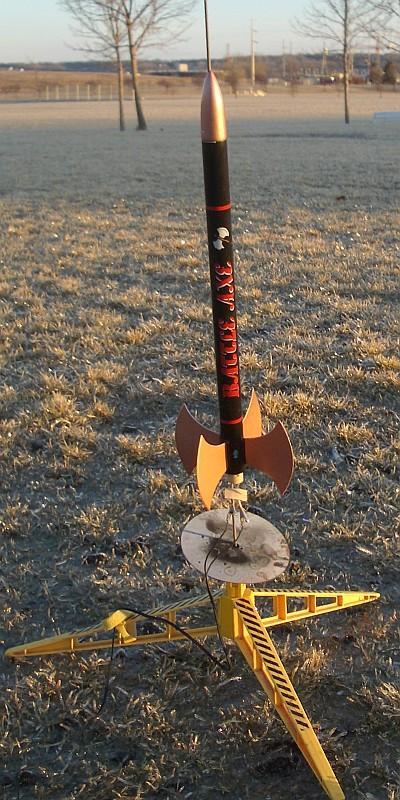
For the first flight, I started out with an A8-3. When I packed the parachute, I put 3 squares of wadding into the body, then formed another two squares into a pouch to protect the chute. The launch was nice and fast with perfect ejection at apogee. Unfortunately, the protective pouch got tangled with the shroud lines and the chute never opened. The rocket landed flat on the ice-coated grass. The fins and body suffered no damage, but the nose cone picked up several stab wounds from the "glass daggers".
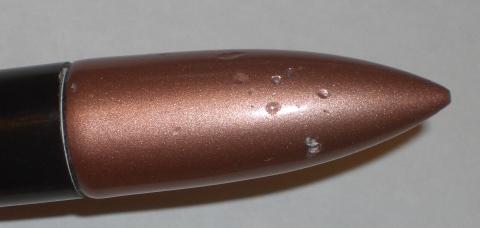
On the second flight we move up to a B6-4 and re-packed the chute without the protective pouch. At ignition it zipped up so fast we lost sight of it for a while. This time the chute ejected and deployed properly and lowered the rocket to a gentle landing. By the time we reached the rocket, the wind had caught the chute and dragged it across the icy field for about 25 feet. The nose cone picked up a few more dents, but nothing else sustained any damage.
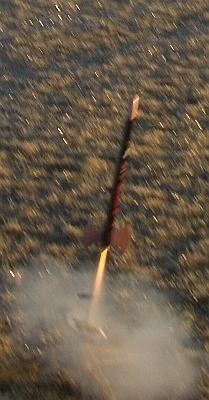
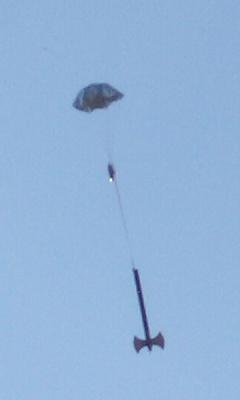
The third flight came 3 months later on a rare spring day with no wind. It shot off the pad on a C6-5 and disappeared for a while. Then we saw the chute open up, and it came down for a gentle landing.
With its light weight and thin fins, this rocket goes much faster and higher than you might expect from looking at it.
Flight Rating: 5 out of 5
OVERALL:
A fun little rocket with great styling and very zippy flight performance.
PROS:
- Good-looking styling.
Good quality parts, especially the laser-cut plywood fins, nose cone, and parachute.
Fairly easy construction.
Great flight performance.
CONS:
- Would prefer a longer shock cord anchor.
Balsa nose cone is very well made, but easily damaged.
Overall Rating: 4 out of 5
Other Reviews
- RocketHead Rockets Battle Axe By Chan Stevens
Definitely not your typical 3-fin and nose cone rocket, the Battle Axe is an interesting design that's fun to build and a surprisingly good flyer. Parts arrived in good shape packed in a sealed plastic bag. The list includes: Basswood fins (precut, a huge plus given their curved design) Balsa nose cone BT-50 body tube 18mm motor mount kit Mylar chute (with Kevlar shroud ...
- RocketHead Rockets Battle Axe By Lance Alligood
The Rockethead Rockets (RR) Battle Axe is a near minimum diameter single stage rocket that flies on 18mm motors & when held near the nose, indeed resembles a battle axe. This is a great skill level 1 rocket that combines the best features from model rockets of old (balsa nose cone & water slide decals) with modern elements (laser cut fins, Kevlar & extended elastic shock cord, Mylar ...
 |
 |
Flights
 |
 |